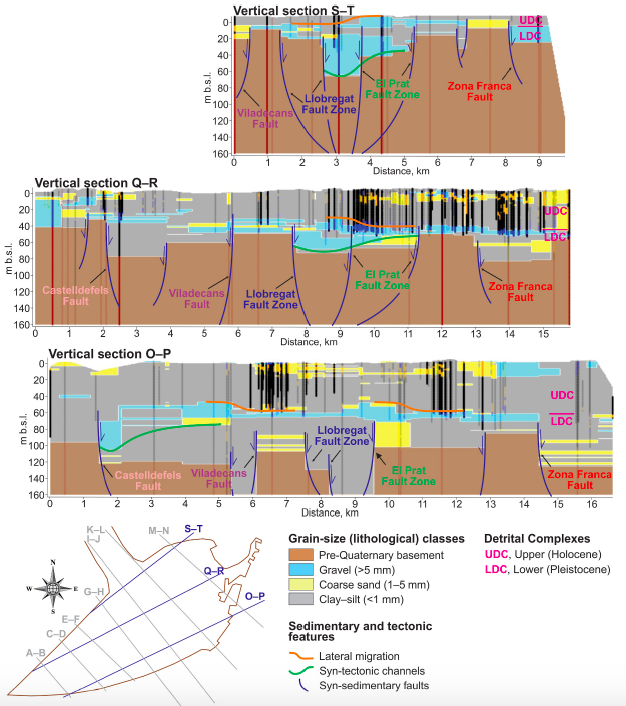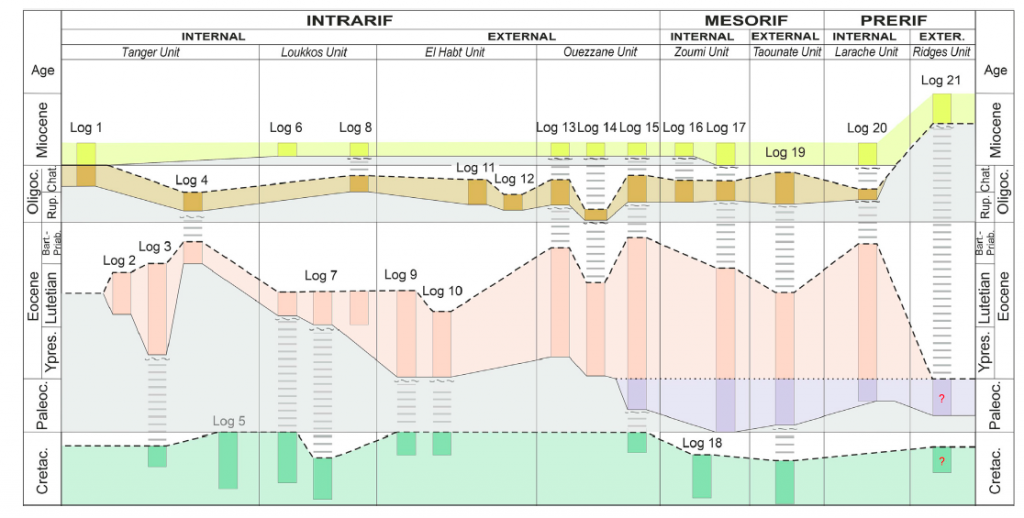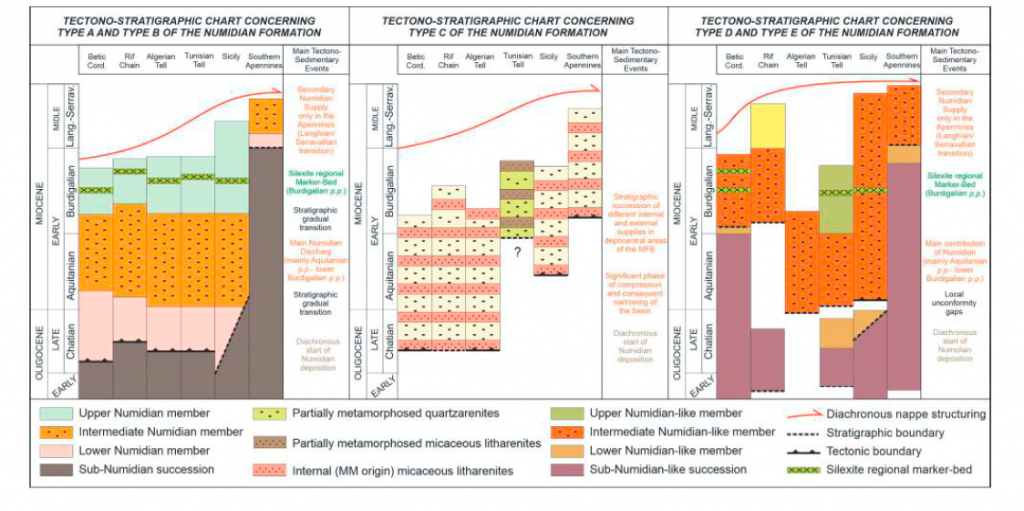Python libraries and k-Nearest neighbors algorithms to delineate syn-sedimentary faults
This paper introduces a methodology based on Python libraries and machine learning k-Nearest Neighbors (KNN) algorithms to create an interactive 3D HTML model (3D_Vertical_Sections_Faults_LRD.html) that combines 2D grain-size KNN-prediction vertical maps (vertical sections) from which syn-sedimentary faults and other features in sedimentary porous media can be delineated. The model can be visualized and handled with conventional web browsers. The grain-size physical parameter is measurable, constant over instrumental time, handleable mathematically, and its range can be associated to lithological classes. Grain-size input data comes from a public database of 433 boreholes in the Llobregat River Delta (LRD) in NE Spain. Four lithological classes were defined: Pre-Quaternary basement, and Quaternary gravel, sand, and clay–silt. Using a new KNN-prediction algorithm, seven NW–SE (transversal) and three SW–NE (longitudinal) vertical sections were created following the orientation of faults identified in surface and detected in reflection seismic geophysical surveys. For exploratory K values in the 1–75 range were used. K around 25 provides the general and smoothy shape of the basement top surface, whereas K = 1 is a optimal value to represent the heterogeneity of the LRD at short distance. Using a new KNN-prediction confidence algorithm inspired in the Similarity Ratio algorithm for machine-learning KNN, the vertical sections overall confidence was evaluated as satisfactory. A general decreasing confidence trend according to the decreasing data density with depth and from inland to seaward was found. The vertical sections created with K = 1 show horizontal interruptions (displacements or vertical steps) in the basement continuity and in the Quaternary coarse bodies (gravel and sand) attributable to the action of Quaternary active faults. These faults have been linked or correlated with well-known active faults in the area related in much cases with the Valencia Trough opening. Moreover, several faults detected in surface and other identified in this paper by the first time have been revealed as fault zones made of fault branches with different steps in an echelon-like arrangement.

Faulting seems to be more evident in the Pleistocene Lower Detrital Complex and much less active or inactive in the Holocene Upper Detrital Complex. Syn-tectonic gravel channels faulty controlled, progradation of gravel lobes, and lateral migration of channel bars were also observed. At its current development stage, this methodology could also be applied to other geological environments, making the due minor modifications of the code, and is especially suitable to reduce the high (usually unmeasurable) uncertainty associated to the qualitative geological data used in more complex numerical tools aimed at modelling a lot of geological resources (groundwater, minerals, geothermal, petroleum) or different Earth phenomena.
Cite as: Martín-Martín, M., Bullejos, M., Cabezas, D., Alcalá, F. J., (2023). Using python libraries and k-Nearest neighbors algorithms to delineate syn-sedimentary faults in sedimentary porous media. Marine and Petroleum Geology, 153. 106283. doi: 10.1016/j.marpetgeo.2023.106283
Paleogene evolution of the External Rif Zone (Morocco) and comparison with other western Tethyan margins
The Paleogene evolution of the NW margin of the African Plate (Western External Rif Zone) was studied by means of multidisciplinary analyses of twenty-one stratigraphic logs, including tectofacies recognition, petro-mineralogical results, and thicknesses analysis. Four stratigraphic intervals were recognized separated by three unconformities coarsely aligned with the Cretaceous–Paleogene, Eocene–Oligocene and Oligocene–Miocene boundaries, respectively. Tectofacies appear from the late Ypresian being more frequents from the Oligocene as the tectonic activity increases. The petrology of detrital suites indicates recycled orogen-derived sediments, with quartz supplied from metamorphic rocks of the Atlas orogen and/or the African craton. On the basis of Mesozoic claymineral assemblages reported in the literature, the clay mineralogy of mudstones suggests upper Jurassic to upper Cretaceous terrains from the Internal Intrarif as the main source area of the Paleocene–Eocene successions, with sediment provenance reversion during the Oligocene and additional contribution of Paleocene to lower Eocene suites. The different displacement capability of the identified aluminic-magnesic claymineralogy enabled to deduce the relative proximity of the source area. These findings point out a complex sedimentary evolution characterized by a mixture of different lithotypes dating back to upper Jurassic. X-ray parameters helped to identify evidences of synsedimentary tectonics overprinting the inheritedmineralogy during some periods with weak burial diagenesis at most.

During the Paleogene a foreland basin is formed mainly in theMesorif and Prerif sub-domains. This foredeep was represented by two ‘sub-geosynclines’ separated by a relative bulge located in the External Mesorif. The Internal Intrarif could represent the relative orogenic front, advancing on the External Intrarif. The Eocene forebulge was located in the Ridges Domain, while the Gharb Basin was the backbulge of the system. During the Oligocene the depocentral area migrated southward and a homogeneization of thicknesses took also place in the whole margin. In this new configuration, the foredeep would be located in the External Mesorif (previously a relative bulge) while the Ridges Domain and the Gharb Basin continued to act as the system forebulge and backbulge, respectively. A comparison with the Paleogene evolution of other western Tethys external margins (Betic Chain, Tunisian Tell, Sicilian Maghrebids, and Apennines) has revealed more similarities than differences. The effects of the Eo-Alpine tectonics are recognized everywhere even if they decrease both from N to S, and from W to E in the different considered margins. The evolution of the compared margins shows a common pre-foredeed (Paleocene-Eocene) and beginning of foredeep (Oligocene) stages in the foreland basins.
Cite as: Martín-Martín, M., Guerrera F., Cañaveras, J. C., Alcalá F. J., Serrano, F., Maaté, A., Hlila, R., Maaté, S., Tramontana, M., Sánchez-Navas, A., and Le Breton, E. (2023). Paleogene evolution of the External Rif Zone (Morocco) and comparison with other western Tethyan margins. Sedimentary Geology, 448, 106367. doi: 10.1016/j.sedgeo.2023.106367
The Numidian formation in the Central-Western Mediterranean
The widely debated late Oligocene-middle Miocene Numidian Fm (NF) consists of supermature quartzose sediments deposited in the Maghrebian Flysch Basin (MFB) outcropping from the Betic Cordillera to the Southern Apennine passing by the Maghrebian Chain. The NF is commonly composed of three lithostratigraphic members and is characterized by two vertical successions (Type A and Type B) corresponding to different sedimentation areas in the MFB. It is noteworthy the occurrence of widespread lateral successions of the NF (Types C, D and E) indicating in some cases an interference of the Numidian sedimentation with other different depositional systems and supplies. The Type C ‘Mixed Successions’, deposited in depocentre areas, are composed of supermature Numidian supply interfingering with immature siliciclastic materials, coming from the internal portion of the MFB. The Type D consists of supermature Numidian materials supplied from the Africa Margin (external sub-domains) deposited in sub-basins on the Africa-Adria margins, outside the typical Numidian depositional area. The Type E, which stratigraphically overlies both the South Iberian Margin (SIM) and the Mesomediterranean Microplate (MM), represents the migration of the Numidian depositional system to reach the opposite margins of the MFB. The occurrence at a regional scale of all the above-mentioned lateral successions reveals a great evolutionary complexity resulting also from further constraints, which must be considered for palaeogeographic and palaeotectonic reconstructions. Another important point deals with the diachronism of the top of the NF, observed eastward from the Betic-Rifian Arc and the Algerian-Tunisian Tell (Burdigalian p.p.) to Sicily (Langhian p.p.) and up to the Southern Apennine (at least Langhian/Serravallian boundary) which can be related with eastwards delay in the MFB closure.

The palaeogeographic reconstruction of the Numidian depositional area presented in this paper,which is also included into a global kinematic model, represents a first attempt to use the software GPlates for this subject.
Cite as: Belayouni, H., Guerrera, F., Martin-Martin, M., Le Breton, E., and Tramontana, M. (2023). The Numidian formation and its Lateral Successions (Central-Western Mediterranean): a review. International Geology Review, DOI: 10.1080/00206814.2023.2199429
Eocene carbonate platform of the Malaguides of the westermost Tethys
The Eocene Peñicas (Almería) and Harania (Málaga) stratigraphic sections from the Malaguide Complex (Betic Cordillera, South Spain) belonging to the Mesomediterranean Microplate from the westernmost Tethys (about 35◦N) have been studied. The Eocene sections cover the Cuisian to middle Lutetian deposits, which show several lithofacies representing shallow marine platform realms. Based on the fossiliferous assemblage, texture and fabrics, eight microfacies related to inner to outer ramp settings were defined. In the inner ramp of the Harania section abundant colonial corals have been recognized. The Eocene deposits are arranged into a transgressive succession composed by three minor transgressive-regressive sedimentary cycles. The Eocene fossiliferous assemblage shows a mixture of photozoan (Larger Bentic Foraminifera, green and red calcareous algae and corals) and heterotrophic (mollusks, echinoids, bryozoans, small benthic and planktic foraminifers) elements, suggesting euphotic to mesophotic conditions in oligo-mesotrophic marine warm-waters at low-middle latitudes. This assemblage indicates a transition from photozoan to heterozoan carbonates and in particular a shift towards outer marine ramp settings.

During the Early Eocene, the widespread distribution of Larger Benthic Foraminifera leads in the Tethyan domains to disappearance or extreme reduction of coral constructions. Nevertheless, abundant corals associated to inner ramp realms have been observed in the Harania stratigraphic section indicating that corals could continue to develop in the westernmost Tethys at the transition to the Atlantic Ocean, in contrast with respect to other Tethyan sectors. Therefore, the Ypresian-Lutetian time-span is a transitional period for the global temperature during which corals locally survived only where optimal ecologic conditions occurred, preferably in marginal contexts, as it seems to have happened in the studied area.
Recent Comments